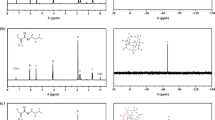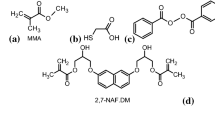Abstract
Polymethyl methacrylate (PMMA) is an important thermoplastic polymer and a versatile lithographic resist. However, the low heat resistance and low dry-etch resistance seriously restricts the application of PMMA in high-end devices and advanced nanolithography. Herein, methyl methacrylate (MMA) was copolymerized with two comonomers 1-adamantyl methacrylate (AdMA) and 1-acryloyloxy-3-hydroxyadamantane (HAdMA), and a series of copolymers P(AdMA-co-MMA) and P(HAdMA-co-MMA) with different contents of HAdMA were prepared. The UV–Vis, ellipsometer, DSC, TG, and TG–MS techniques were employed to investigate the effects of adamantyl and hydroxyadamantyl substituents on the optical and thermal properties of PMMA. The introduced hydroxyadamantyl not only significantly enhanced the refractive index, but also maintained the high transparency and low dispersion of PMMA. The glass transition temperature and thermal stability of PMMA were also greatly improved by the hydroxyadamantyl. The initial decomposition temperature of PMMA increased from 160 to about 260 ℃ after introducing 5% HAdMA. HAdMA was more effective than AdMA in improving the optical and thermal properties of PMMA. The novel P(HAdMA-co-MMA) copolymer has overcome the shortcomings of traditional PMMA and is anticipated to significantly broaden its range of applications.











Similar content being viewed by others
References
Ali U, Karim KJBA, Buang NA (2015) A review of the properties and applications of poly (methyl methacrylate) (PMMA). Polym Rev 55(4):678–705
Khan A, Lee S, Jang T, Xiong Z, Zhang C, Tang J, Guo LJ, Li WD (2016) High-performance flexible transparent electrode with an embedded metal mesh fabricated by cost-effective solution process. Small 12(22):3021–3030
El-Gamal S, Ismail AM (2020) Electrical and optical properties of novel brilliant cresyl bluedye-doped poly (methyl methacrylate) as selectivecut-offlaser filters. Polym Int 69(12):1308–1318
Shankar U, Gupta CR, Oberoi D, Singh BP, Kumar A, Bandyopadhyay A (2020) A facile way to synthesize an intrinsically ultraviolet-C resistant tough semiconducting polymeric glass for organic optoelectronic device application. Carbon 168:485–498
Begum SA, Rane AV, Kanny K (2020) Applications of compatibilized polymer blends in automobile industry. Compat Polym Blends 20:563–593
Tseng AA, Kuan C, Chen CD, Ma KJ (2003) Electron beam lithography in nanoscale fabrication: recent development. IEEE Trans Electron Packag Manuf 26(2):141–149
Fredriksson H, Alaverdyan Y, Dmitriev A, Langhammer C, Sutherland DS, Zäch M, Kasemo B (2007) Hole-Mask colloidal lithography. Adv Mater 19(23):4297–4302
Rahman F, Carbaugh DJ, Wright JT, Rajan P, Pandya SG, Kaya S (2020) A review of polymethyl methacrylate (PMMA) as a versatile lithographic resist – with emphasis on UV exposure. Microelectron Eng 224:111238
Gangnaik AS, Georgiev YM, Holmes JD (2017) New Generation electron beam resists: a review. Chem Mater 29(5):1898–1917
Gross S, Camozzo D, Di Noto V, Armelao L, Tondello E (2007) PMMA: a key macromolecular component for dielectric low-κ hybrid inorganic–organic polymer films. Eur Polym J 43(3):673–696
Sun H, Chan CW, Wang Y, Yao X, Mu X, Lu X, Zhou J, Cai Z, Ren K (2019) Reliable and reusable whole polypropylene plastic microfluidic devices for a rapid, low-cost antimicrobial susceptibility test. Lab Chip 19(17):2915–2924
Dore C, Osmond J, Mihi A (2018) A water-processable cellulose-based resist for advanced nanofabrication. Nanoscale 10(37):17884–17892
Carbaugh DJ, Pandya SG, Wright JT, Kaya S, Rahman F (2017) Enhancing the dry-etch resistance of polymethyl methacrylate patterned with electron beam lithography. J Vac Sci Technol B Nanotechnol Microelectron 35(4):041602
Lewis SM, Hunt MS, DeRose GA, Alty HR, Li J, Wertheim A, De Rose L, Timco GA, Scherer A, Yeates SG, Winpenny REP (2019) Plasma-Etched pattern transfer of sub-10 nm structures using a metal-organic resist and helium ion beam lithography. Nano Lett 19(9):6043–6048
Kerber GL, Kleinsasser AW, Bumble B (2009) Fabrication of submicrometer high current density Nb/Al-ALNx/Nb junctions. IEEE Trans Appl Supercond 19(3):159–166
Stoneham AM, Matthews JR, Ford IJ (2004) Innovative materials for fusion power plant structures: separating functions. J Phys: Condens Matter 16(27):2597-S2621
Wang F, Diesendruck CE (2018) Polyphthalaldehyde: synthesis, derivatives, and applications. Macromol Rapid Commun 39(2):1700519
Turchanin A, Gölzhäuser A (2012) Carbon nanomembranes from self-assembled monolayers: functional surfaces without bulk. Prog Surf Sci 87(5–8):108–162
Demir MM, Koynov K, Akbey Ü, Bubeck C, Park I, Lieberwirth I, Wegner G (2007) Optical properties of composites of PMMA and surface-modified zincite nanoparticles. Macromolecules 40(4):1089–1100
Rezaei F, Abbasi-Firouzjah M, Shokri B (2014) Investigation of antibacterial and wettability behaviours of plasma-modified PMMA films for application in ophthalmology. J Phys D Appl Phys 47(8):085401
Tsai C-W, Wang J-C, Li F-N, Chang Y-C, Wu K-H (2016) Synthesis of adamantane-containing methacrylate polymers: characterization of thermal, mechanical, dielectric and optical properties. Mater Express 6(3):220–228
Tang L, Zhang J, Tang Y, Kong J, Liu T, Gu J (2021) Polymer matrix wave-transparent composites: a review. J Mater Sci Technol 75:225–251
Wu Z, He J, Yang H, Yang S (2022) Progress in aromatic polyimide films for electronic applications. Polymers 14(6):1269
Cho MJ, Choi DH, Sullivan PA, Akelaitis AJP, Dalton LR (2008) Recent progress in second-order nonlinear optical polymers and dendrimers. Prog Polym Sci 33(11):1013–1058
Tsai C-W, Wu K-H, Wang J-C, Shih C-C (2017) Synthesis, characterization, and properties of petroleum-based methacrylate polymers derived from tricyclodecane for microelectronics and optoelectronics applications. J Ind Eng Chem 53:143–154
Wu K-H, Tsai C-W, Huang W-C, Hung W-C (2021) Structural design and characterization of tricycloalkyl-containing methacrylate with methyl methacrylate copolymers. Mater Sci Eng, B 267:115088
Wu W, Ouyang Q, He L, Huang Q (2022) Optical and thermal properties of polymethyl methacrylate (PMMA) bearing phenyl and adamantyl substituents. Colloids Surf A 653:130018
Rakhshani MR, Mansouri-Birjandi MA (2017) High sensitivity plasmonic refractive index sensing and its application for human blood group identification. Sens Actuators B Chem 249:168–176
Liu J-G, Ueda M (2009) High refractive index polymers: fundamental research and practical applications. J Mater Chem 19(47):8907–8919
Lü C, Yang B (2009) High refractive index organic–inorganic nanocomposites: design, synthesis and application. J Mater Chem 19(19):2884–2901
Higashihara T, Ueda M (2015) Recent progress in high refractive index polymers. Macromolecules 48(7):1915–1929
Eppig T, Rawer A, Hoffmann P, Langenbucher A, Schroder S (2020) On the chromatic dispersion of hydrophobic and hydrophilic intraocular lenses. Optom Vis Sci 97(4):305–313
Arabeche K, Delbreilh L, Adhikari R, Michler GH, Hiltner A, Baer E, Saiter J-M (2012) Study of the cooperativity at the glass transition temperature in PC/PMMA multilayered films: influence of thickness reduction from macro- to nanoscale. Polymer 53(6):1355–1361
Acknowledgment
This work was supported by the Ningbo “3315 Plan” Innovation Team Project (2018A-03-A) and Top Talent Project.
Funding
Ningbo “3315 Plan”, Innovation Team Project, 2018A-03-A, Top Talent Project.
Author information
Authors and Affiliations
Contributions
Weilong Wu is mainly responsible for formal analysis, investigation, data collation, writing—manuscript preparation, and visualization. Shihao Feng is mainly responsible for validation and visualization. Qin Ouyang is mainly responsible for conceptualization, writing—review and editing, supervision, and visualization. Zengzhuan Yang is mainly responsible for validation. Liu He is mainly responsible for resources and supervision. Qing Huang is mainly responsible for supervision and project administration.
Corresponding author
Ethics declarations
Conflict of interest
There are no conflicts to declare.
Additional information
Publisher's Note
Springer Nature remains neutral with regard to jurisdictional claims in published maps and institutional affiliations.
Rights and permissions
Springer Nature or its licensor (e.g. a society or other partner) holds exclusive rights to this article under a publishing agreement with the author(s) or other rightsholder(s); author self-archiving of the accepted manuscript version of this article is solely governed by the terms of such publishing agreement and applicable law.
About this article
Cite this article
Wu, W., Feng, S., Ouyang, Q. et al. A novel polymethyl methacrylate (PMMA) with excellent optical and thermal properties-bearing hydroxyadamamtyl substituent. Polym. Bull. (2024). https://doi.org/10.1007/s00289-024-05286-x
Received:
Revised:
Accepted:
Published:
DOI: https://doi.org/10.1007/s00289-024-05286-x




